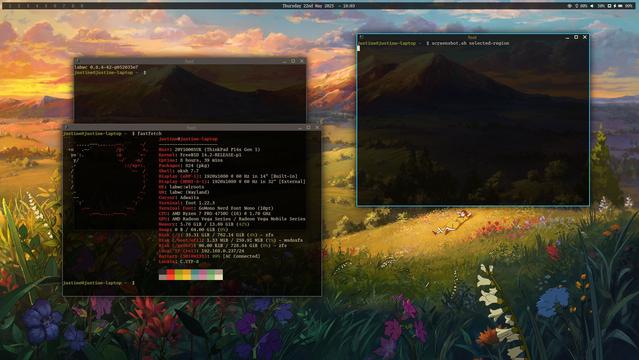<DUCKS_AND_RUNS>
😃
CC: @withaveeay@mastodon.scot
Very nice background, but what a those options that were not yet available? I've been using xfce for years and the transparency and snapping has always been there.
I read about Wayland and several apps having problems with it. What is the big plus of Wayland?
Security, for one thing. With X, every app can read all your keystrokes, for example.
@jerry1970 @justine X is in maintenance mode and has been for years now, and most of the work being done is in aid of the xwayland compatibility layer. It's a very old codebase that's become difficult to work with and has structural security flaws (e.g. every application running in an x server can be a silent keylogger). Development has been focused on Wayland and the xwayland compatibility layer for some time, even RHEL 10 has officially dropped X11, it's not even available in the official repos.
Wayland is reaching an inflection point where most of it's usability issues (usually stemming from it's focus on security), have been solved with protocols and portals, and Wayland compositors and applications are adopting these features.
Over time depending on how much community support there is for the X server it will fall victim to bitrot and become increasingly broken on modern systems. Eventually popular toolkits and applications will cease to function anyway or require hacky workaround compatibility layers.
@jerry1970 @justine what compositor/WM/DE did you try? GNOME and KDE have by far the most mature Wayland experience, with hyprland and sway being the most mature standalone WMs (this is assuming Linux, no idea what Wayland is like in BSD land)
Hopefully soon we'll see more choice for mature wayland compositors!
Sorry for my lack of knowledge on this part, I am a software developer but that part has never been of interest to me. I think it's time I learn a little bit more so at least I understand the talk... ;)
@jerry1970 @justine I think there are some architectural advantages to Wayland, but the main thing in my mind is developer support for X.org is dwindling. It’s an old code base and it’s not easy to work on. It looks like there are still some people fixing security issues, but it’s sporadic. About three updates a year. https://x.org/wiki/Development/Security/
That’s probably okay now, but it will become increasingly less okay as time goes on.
@justine Reading up on window managers I come across "Qtile is a customizable tiling window manager that works on X11 and Wayland." So X11 and Wayland are not window managers? I am confused. What do X11 and Wayland do then? And in Xubuntu, what is the window manager I am using?
I read some apps do not work on Wayland. I'd like to find a list of which those are.
And most importantly, I love my desktop experience with windows (styling, snapping to screen and each other) and using the mouse and keyboard (alt-right-drag to resize etc.). Does that work the same?
https://linuxiac.com/xorg-x11-wayland-linux-display-servers-and-protocols-explained/
Wayland will become the standard one day (tho imo it has been ready for years).
Qtile serves as an XOrg window manager and as a Wayland compositor, but most others follow only either.
I3, for instance, works on X11 and the Wayland analogue is called Sway (this need not be the case; indeed i3 is probably the only X11 WM that has a direct Wayland compositor counterpart)
Xubuntu uses a desktop environment called XFCE; Wayland support is (still) experimental on XFCE.
Again, think of X11 and Wayland as 2 very different ways to run a GUI (again, apologies for the oversimplification).
XOrg apps work on Wayland through a "bridge" called XWayland. Wayland-native apps don't work on X11 AFAIK.
Hope this simplifies things! (Feel free to get back in case you have any further queries)
And to the advanced readers, I know I've made mistakes and oversimplifications, but this is just for ease of understanding.
- Wayland compositors should behave almost exactly like X11 WMs.
- you might need to tweak XCompose settings (ignore if you have no idea what this is)
- stuff like drag and drop should work fine (mostly if not always), but again, this is dependent on the implementation (I might be wrong about this)
XOrg/X11 serves as a base for DEs and WMs. Many "features" can be, in a sense, shared.
It is up to Wayland compositors to implement protocols, and so features may vary. Some don't support idle daemons yet, some support everything (Hyprland is an excellent Wayland compositor for instance)






